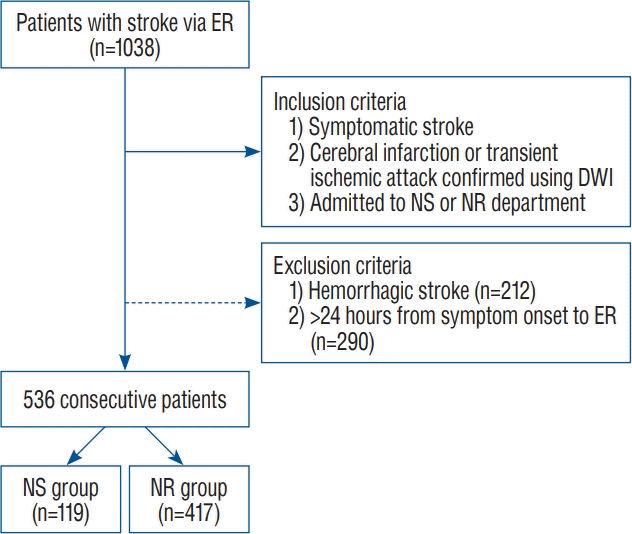1. Atallah E, Bekelis K, Saad H, Chalouhi N, Dang S, Li J, et al. A comparison of two stroke cohorts cared for by two different specialties in a practice-based tele-stroke population. Clin Neurol Neurosurg. 168:67–71. 2018.
2. Candelise L, Gattinoni M, Bersano A, Micieli G, Sterzi R, Morabito A, et al. Stroke-unit care for acute stroke patients: an observational followup study. Lancet. 369:299–305. 2007.
3. Costalat V, Lobotesis K, Machi P, Mourand I, Maldonado I, Heroum C, et al. Prognostic factors related to clinical outcome following thrombectomy in ischemic stroke (RECOST study). 50 patients prospective study. Eur J Radiol. 81:4075–4082. 2012.
4. Hand PJ, Kwan J, Lindley RI, Dennis MS, Wardlaw JM. Distinguishing between stroke and mimic at the bedside: the brain attack study. Stroke. 37:769–775. 2006.
5. Kicielinski KP, Ogilvy CS. Role of the neurosurgeon in acute ischemic stroke treatment from triage to intensive care unit. Neurosurgery. 85:S47–S51. 2019.
6. Kim JY, Kang K, Kang J, Koo J, Kim DH, Kim BJ, et al. Executive summary of stroke statistics in Korea 2018: a report from the epidemiology research council of the Korean Stroke Society. J Stroke. 21:42–59. 2019.
7. Kim JY, Lee KJ, Kang J, Kim BJ, Kim SE, Oh H, et al. Acute stroke care in Korea in 2013-2014: national averages and disparities. J Korean Med Sci. 35:e167. 2020.
8. Kim SH, Nam TM, Jang JH, Kim YZ, Kim KH, Kim DH, et al. Improving door-to-puncture time in mechanical thrombectomy with direct care from a neurointerventionalist in the emergency department. World Neurosurg. 152:e455–e461. 2021.
9. Lee HJ, Shin DH, Yang KI, Koh IS, Lee KB, Lee WW, et al. The investigation on the burden of neurology residents to manage the patient who received thrombolytic treatment in the emergency department with hyperacute stroke. J Korean Neurol Assoc. 39:305–311. 2021.
10. Lee KB, Park HK, Park TH, Lee SJ, Bae HJ, Lee KS, et al. Policy making committee, the Korean Stroke Society. Current status and problems of stroke units in Korea: results of a nationwide acute care hospital survey by the Korean Stroke Society. J Korean Neurol Assoc. 33:141–155. 2015.
11. Lee SU, Kim T, Kwon OK, Bang JS, Ban SP, Byoun HS, et al. Trends in the incidence and treatment of cerebrovascular diseases in Korea : part II. Cerebral infarction, cerebral arterial stenosis, and moyamoya disease. J Korean Neurosurg Soc. 63:69–79. 2020.
12. Muñoz Venturelli P, Robinson T, Lavados PM, Olavarría VV, Arima H, Billot L, et al. Regional variation in acute stroke care organisation. J Neurol Sci. 371:126–130. 2016.
13. Park H, Kim BM, Baek JH, Kim JH, Heo JH, Kim DJ, et al. Predictors of good outcomes in patients with failed endovascular thrombectomy. Korean J Radiol. 21:582–587. 2020.
14. Reeves M, Khoury J, Alwell K, Moomaw C, Flaherty M, Woo D, et al. Distribution of national institutes of health stroke scale in the Cincinnati/ Northern Kentucky stroke study. Stroke. 44:3211–3213. 2013.
15. Rizos T, Ringleb PA, Huttner HB, Kohrmann M, Juttler E. Evolution of stroke diagnosis in the emergency room--a prospective observational study. Cerebrovasc Dis. 28:448–453. 2009.
16. Rudd AG, Hoffman A, Irwin P, Lowe D, Pearson MG. Stroke unit care and outcome: results from the 2001 National Sentinel Audit of Stroke (England, Wales, and Northern Ireland). Stroke. 36:103–106. 2005.
17. Stroke Unit Trialists' Collaboration. Organised inpatient (stroke unit) care for stroke. Cochrane Database Syst Rev. 2013:CD000197. 2013.





 PDF
PDF Citation
Citation Print
Print






 XML Download
XML Download